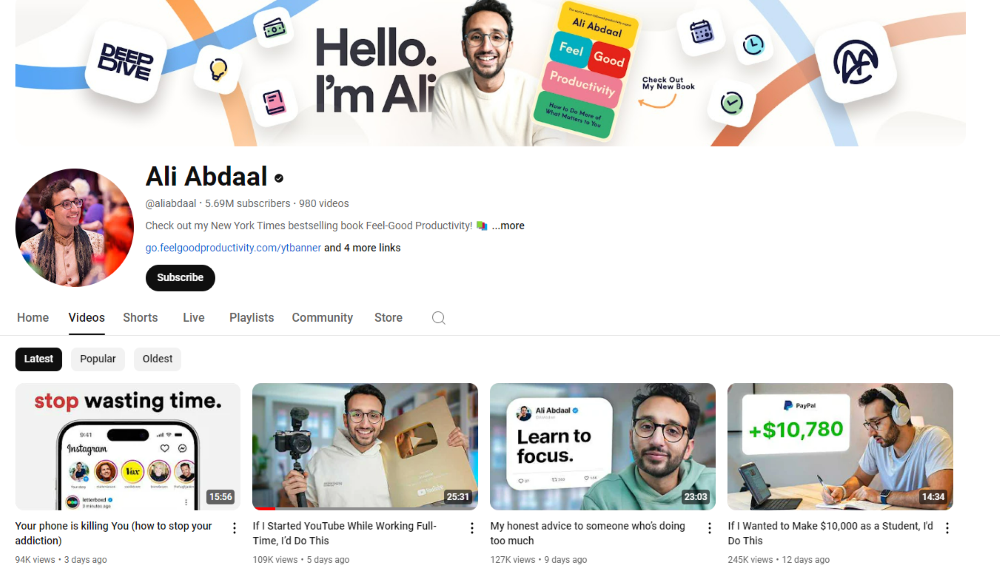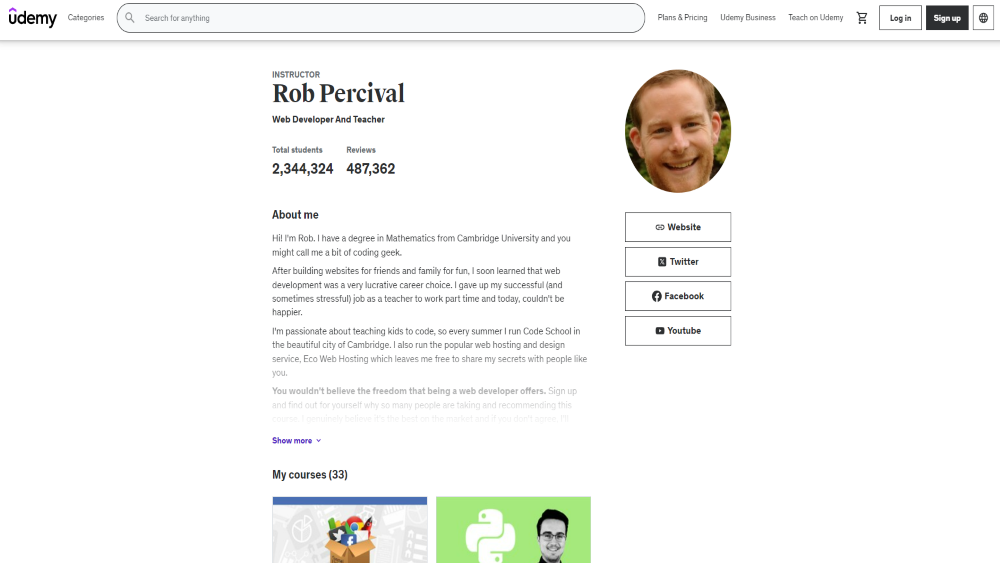

The idea of teaching online and making millions from it may seem like an impossible dream. However, every millionaire educator started off with no more than an idea for a course and a handful of students. Their dedication, passion for their subject, creativity, and ability to leverage a range of different strategies helped them succeed, turning their expertise into millions of dollars.
If you’re thinking, “I want to teach online and earn money,” this doesn’t have to be a pipe dream. With millions of people turning to online classes every year to learn additional skills or further their careers, there’s never been a better time to get started. Here’s how.
Since online learning started to make an appearance in the early 2000s, it has set a steady track, growing more rapidly than ever before. According to Fortune Insights, the online course market is on track to reach $319 Billion by 2029.
Some of the most prominent subjects and skills in demand include:
The #1 to make money online with TikTok Search (FREE TRAINING)

The rise of online education platforms, such as Patreon, Kajabi, and Teach, has been transformative for online education, changing the landscape of e-learning and making new skills more accessible than ever before. However, with this influx, there has also been an increase in online educators taking over niches such as fitness, business and marketing, graphic design, and more. This has made standing out a lot harder now than it used to be.
However, that’s not to say new and emerging online educators still can’t build a sustainable career or even become a millionaires through teaching online.
With online education growing every day, some niches and opportunities are yet to be taken full advantage of. Examples include:
If you wish to become a millionaire by teaching online, it’s important to pick a topic that still aligns with your passions. If you have experience in fitness coaching but choose to specialize in data science, your audience will notice your lack of passion and knowledge, making students less likely to join your course. Make a note of areas you’re passionate about and break them down into subcategories. This will help you pick a less saturated topic.
Once you’ve decided on a niche, research your competitors. See if they offer the same things as you, and if they do, come up with ways to improve yours. This will help you stand out in a saturated market.
If you already have an existing niche and want to make it more profitable, ask for audience feedback. Use surveys, polls, or anonymous online ask boxes to discover which areas they’re interested in learning more about.

If you want to become a millionaire by teaching online in 2024, it may seem like an overwhelming task. However, breaking everything down into smaller steps and strategies is important for reaching your goals.
Identifying your niche is crucial to determining your target audience. From there, you can decide what type of content to offer.
Choose a niche based on both market demand and your expertise. Don’t choose a niche with a high market demand that you’re not passionate or knowledgeable about, as this may cost you more in the long run in terms of time and resources.
Developing personas will give you an effective starting point, helping you understand your audience and tailor your content and marketing strategies to them. Here’s how to develop personas that will help you create an effective content strategy.
Once you’ve developed your audience personas, you’ll be in a much better position to create an effective content strategy that engages and retains your students.
The right content is key to teaching successfully online and making millions. Creating captivating content that resonates with your audience will help you build a more engaged community that others want to join.
Although content will be different for every niche, there are a variety of features that good, engaging content all has in common.
It’s not enough to create content that resonates. Millionaire teachers and content creators all have one thing in common: they provide easily accessible high-quality content. Their infographics and articles are branded, fitting the voice and feel of the creator. Furthermore, they offer professional video quality, whether it’s a full online course or a thirty-second TikTok.
The unprofessionalism of grainy videos, static, and pixelated images are enough to create mistrust and turn potential students away.
Consider investing in high-quality equipment. A good camera and microphone will help you deliver clean, crisp audio. Exporting high-resolution files and images will ensure everything is readable and professional. It’s also important to update content regularly with new information or better quality. Seeking to continuously improve your teaching will show students that you take your course content seriously.

Choosing the right platform to host your courses is essential to becoming a millionaire. Every platform has different features and functions to help you offer your students the value they deserve. Here are some of our top choices.
Teach.io is a platform that brings courses and community building together, offering an easy way to turn passion into profit. It has everything you need in one place – build courses, chat with students, schedule and host live events, and more without switching apps. Here are some of its best features:
All of this makes Teach an excellent choice for any education business, coach, or entrepreneur looking to turn their passion into a million-dollar business, whether you’re teaching languages to hundreds of students or setting up a training business.
Try Teach’s 14-day free trial.
Skillshare is specifically designed for creatives to teach their passions to others. Artists, designers, musicians, writers, and other creatives can all use this platform to monetize their expertise, with top-earning teachers making $100,000+ every year. Once you’ve been approved to join the platform, you can create classes or one-to-one tutoring sessions. Here’s what makes Skillshare stand out:
Because Skillshare is a fantastic resource for creatives, it might not be the best option for businesses or coaches who want their own branding.
Udemy is a popular course-creation platform that lets you teach your way. With 70 million students and 970 million enrollments within 180+ countries, there is a vast audience for you to teach your expertise. Teachers at Udemy earn money from every single student who enrolls in their course. Here’s why Udemy is worth considering:
Udemy is a fantastic option for beginners. With a range of resources to help teachers publish their first course, anyone can start teaching.
Different platforms will have different setup requirements and video lengths. Make sure to research this before uploading content onto your platform. For example, Skillshare has specific guidelines you’ll need to follow for content to be approved and published, whereas Udemy doesn’t require you to teach in front of a camera as long as you record the screen.
No matter the guidelines, make sure your content is professional and clear. Good presentation will mean more viewers and a larger revenue.

Once you’ve set up your course, you must choose your pricing model. The right pricing model will differ for every business, depending on their services and products. Here are three popular pricing models and whether they’re a good fit for your business.
This is where customers pay a set price to get access to a service or a course. For example, they may pay a flat fee of $599 for a 10-week course, or they may even pay $2000 for an intensive three-month group coaching course. This pricing model works well if you’re planning to create one course, product, or service without planning to make any changes. Examples of one-time payment models include webinars, classes and workshops, ebooks, or even consultancy packages.
This payment model may require less worth than others, especially if you plan to offer only one or two products. However, it limits recurring content, which can be essential for helping businesses grow. Furthermore, the content you provide must be worth the asking price. Otherwise, you may end up refunding and losing money.
A subscription-based pricing model is where customers pay a recurring fee for regular access to a product or service. Popular examples include Netflix, Photoshop, and even a gym membership. The time between payments may vary from company to company, with weekly, monthly, and annual subscriptions available depending on the niche.
This payment model lets companies and businesses acquire recurring payments, which may be more sustainable in the long run than one-off payments. However, if the quality of the content or service drops or there’s a big shift in trends, companies might find themselves losing members and, thus, their income.
Tiered pricing is when businesses and companies offer varying levels of value at different prices. This model acts as a value ladder, with a different price point for every step—or “tier.” The higher the tier they choose, the more they pay, but the more value they get.
Patreon is a fantastic example of a tiered system, with various creators on the platform offering different services at different price points. For example, a creator may only offer digital products at the first tier, such as digital wallpapers, planners, and calendars. However, that may increase to physical products, in addition to the digital ones, for the next tiered pricing. A third tier may offer all this and custom products.
Psychological pricing is a strategy that uses specific techniques to make the price more appealing without undervaluing the content, using consumer psychology to influence the customer’s purchasing decisions. Different techniques can have different effects, including creating urgency or a sense of exclusivity.
Here are some examples:
Marketing your courses is essential to building your audience and turning them into paying customers who will help you become a millionaire. The following simple strategies can make a big difference in your marketing efforts.
Building a personal brand will help you connect with your audience on a deeper level. You won’t just be a service provider – they’ll feel like they know and relate to you, inspiring trust in both you and your products.
Building a personal brand takes time and persistence, but the reward is an engaged and trusting audience that acts as brand ambassadors and advocates for your courses. If you’re not sure where to start, these ideas should help.
Learning and using basic SEO strategies in your content, website, and courses will help you rank higher on search engines and improve visibility. SEO encompasses a great many strategies, a few of which include:
Social media can be fickle, but email marketing lets you curate an engaged audience so you can send offers, discounts, and information directly to them. Create email-only guides and infographics, a newsletter with exclusive information, or deals and discounts they won’t get anywhere else. These strategies will help your email list grow.
To build a thriving and sustainable community that makes millions, you need to engage and retain your community members, as well as attract new ones. Use a mix of interactive content and live sessions to keep students engaged and give them enough value. Try a range of different content types to see what works best and gets the most engagement.
Moreover, ask for and implement audience feedback. Use websites like SurveyMonkey, Google Forms, and polls or even anonymous ask boxes to encourage feedback. Ask which content they prefer and what topics they’d like to see more of in the future. From here, you can adjust your content strategy to align with your existing audience’s wants and needs, helping you engage and retain members.
The #1 to make money online with TikTok Search (FREE TRAINING)

Once you’ve set up your business, you can start scaling it to make more money. Consider outsourcing your content to other creators, as this will free up your time and allow you to work on other aspects of your business. Furthermore, you could automate your content and schedule everything in advance. This means you don’t have to manually post each content piece, which, once again, will free up your time for other priorities.
Consider expansion strategies, such as diversifying your course offerings or exploring other revenue streams, such as books, podcasts, or consulting. These additional revenue streams will help you appeal to a broader audience, thus attracting new customers and even making you millions.
Tracking the success of your online business will help you make adjustments to optimize your offerings and bring in a bigger audience. Use analytics tools such as Google Analytics to track metrics. Monitoring things like audience engagement per post, community growth, member retention rate, user satisfaction, post reach, and more will help you understand the health of your community.
Once you’ve tracked specific metrics, you can identify which areas need improvement. From here, you can improve your courses, content, and marketing strategies based on the data.
If you want to become a millionaire by teaching online, it’s best to look at the experts. These educators and content creators have taken their online platforms and turned them into successful revenue generators, helping them become millionaires. All the creators on this list belong to different niches, proving that if you have passion, dedication, and creativity, you can thrive no matter what topic you’re teaching.

Ali Abdaal is the owner of the community, Productivity Lab, which brings together creators, professionals, entrepreneurs, and anyone else who wishes to maximize their productivity and achieve their dreams. He has a vast audience of 5.69M YouTube subscribers and 903K Instagram followers.
Abdaal started off as a doctor and chose to set up his YouTube channel while he was at university to share advice on medicine, studying, and productivity. Since then, his brand has skyrocketed to new heights, leading him to open up new revenue streams and make content in the form of books, courses, and even a Podcast.
Follow Ali Abdaal on YouTube, Instagram, and X.

Rob Pervial is a former mathematics teacher turned coding expert with over 2,344,207 students on Udemy following his every word. He earned his expertise by building websites for friends and family; however, he soon noticed a huge community of people out there who wanted to learn code but didn’t have the skills.
Follow Rob Percival at Udemy or on LinkedIn.
This sourdough enthusiast turned her passion for baking into profit, making a series of successful courses on Udemy, teaching her students how to make proper sourdough bread. She has her own community, The Baking Network, and has garnered more than 45,621 students on Udemy. She’s a prime example of how you can turn any passion into a profitable business.
You can check out Teresa Greenway’s courses on Udemy.

Joseph Michael started off as a copywriter and blogger who struggled to get started with the popular writing software, Scrivener, despite his own technical knowledge. While researching how to master the platform, Michael came across other people who had the same problem. This was how he came up with creating his million-dollar-making course: Learn Scrivener Fast.
Find Joseph Michael on Learn Scrivener Fast and X.

Timothy Sykes is another niche creator who has turned his knowledge and experience about stock trading into millions of dollars through his lessons on trading penny stocks. However, Sykes was actually a self-made millionaire before he even started teaching, having made his first million from $12,415 of bar mitzvah money given to him by his parents. Since then, his Trading Challenge has helped students become millionaires themselves.
Follow Timothy Sykes on his website or through his Instagram and X.
Becoming a millionaire through online teaching may seem daunting, but with the right niche, strategies and knowledge, you can create a sustainable and profitable online teaching business. Many of the example millionaires on this list adopt a range of strategies, such as building a community and selling products or services in addition to creating course content.
If you’re looking for a platform that encompasses both courses and community, consider Teach.io.





